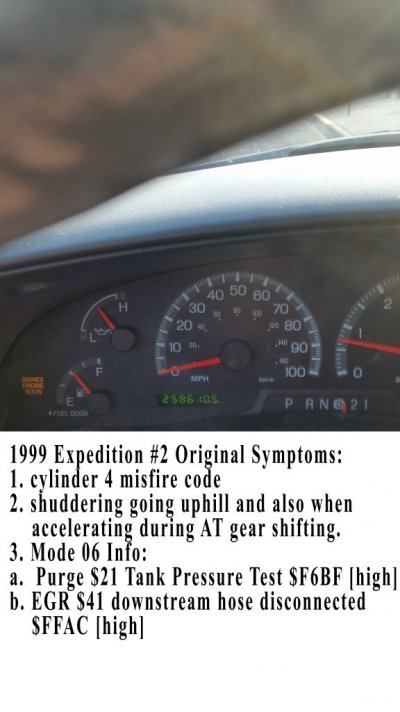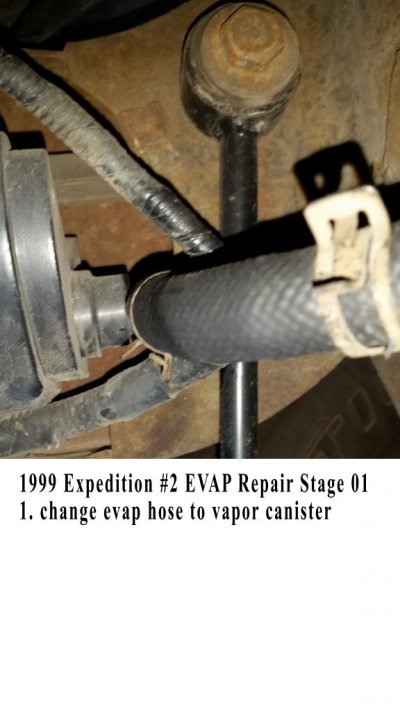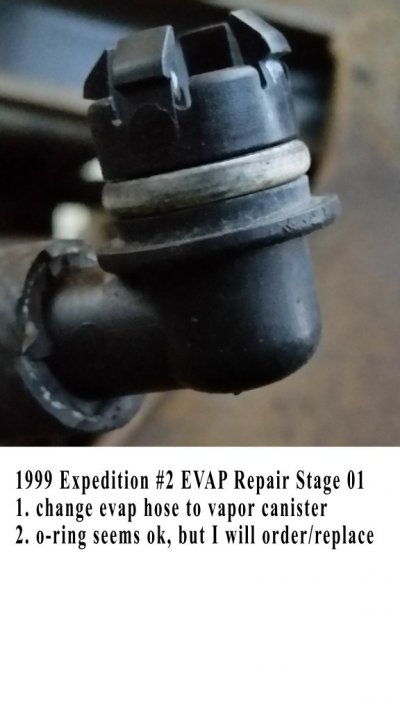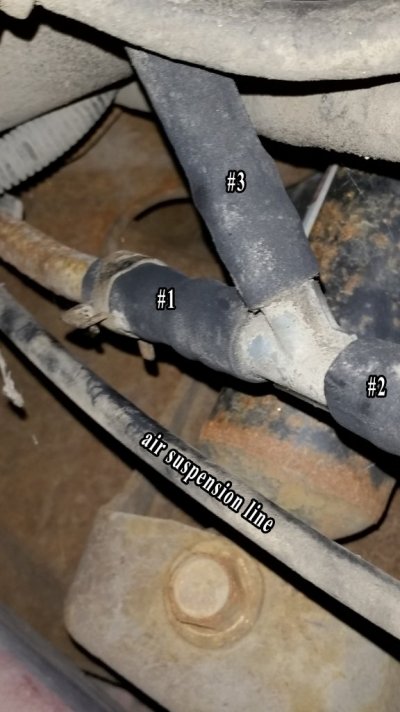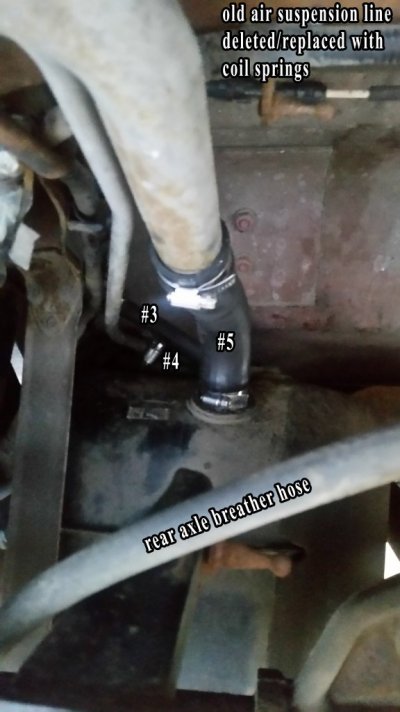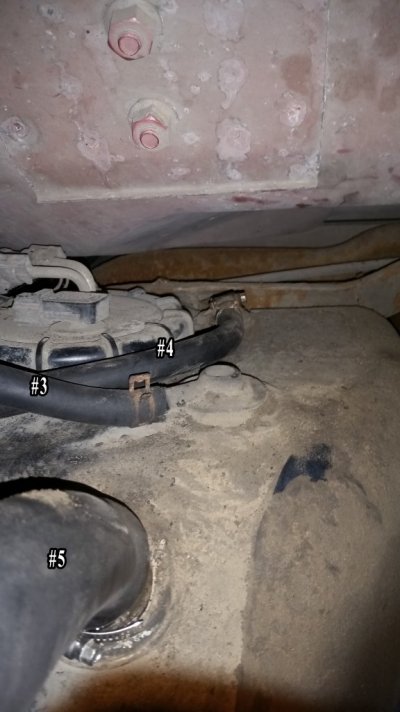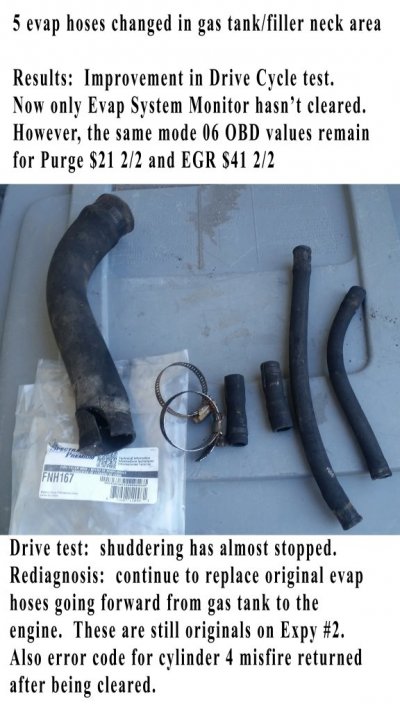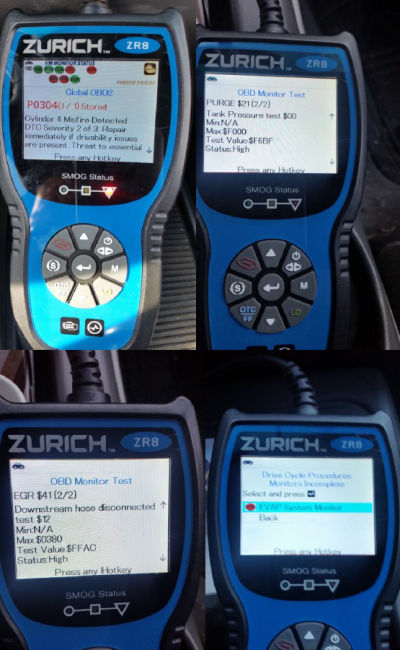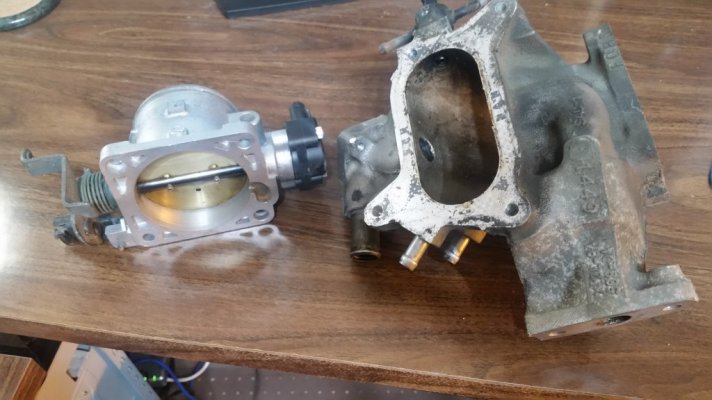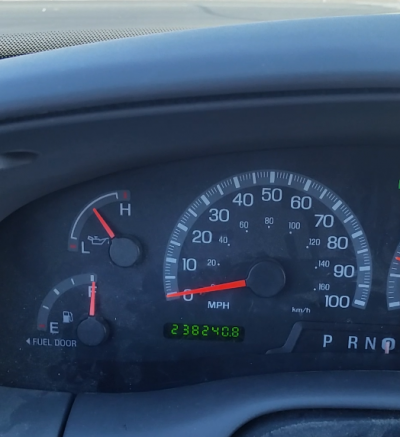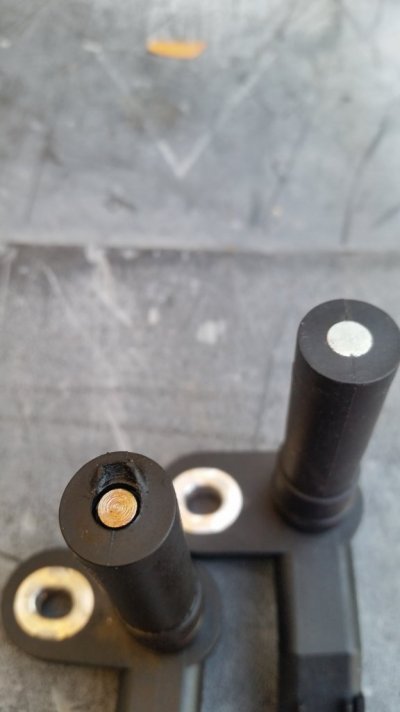I have two 1999s 5.4s. One I've had for over 20 years and the second one for about 5 years. They both have the exact same problem: 304 code (cylinder 4 misfire). The other clue is that the trip cycles won't complete for the catalyst monitor and the evap system monitor.
Expy #1 is the one that I've had the longest. For no other reason than that I've been working only that one. #1 also has a very small amount of valve clatter like you might hear in an 8-cylinder with 250,000 miles. Wife can't hear it, but I can. Expy #2 doesn't have any valve noise at all.
Road situation: In town there is no difference at all in driving quality. It's normal. But out on open road, going uphill there is a chopiness and slight shaking. If I turn off the overdrive the shaking stops at the point that the engine is running an additional 500 rpms faster.
-spark plugs- -coils- -injectors- all checked, rotated and triple-checked. all functioning normally.
-coolant leaks- verified by driving several hundred miles with a white cotton towel covering cylinder 4 area and the underside of coolant quick connectors. No leaks.
-egr system- verified underhood. No vacuum leaks.
-evap system- verified underhood. followed to the evap connector hose located underneath the frame near the front driver's side tire. No vacuum leaks.
Early last Spring I decided to change the intake manifold. I installed a Ford replacement intake manifold. I bought several intake manifolds on closeout for 100 bucks about 10+ years ago. It was dry underneath the manifold (except for small amount of coolant released during teardown) I did see some evidence of an earlier coolant leak or spill underneath the intake manifold. This was before I owned it. I vacuumed out a lot of dry crumbly rust. Since I was in the general vicinity, I checked the block sensor and the coolant tube. You may assume that the manifold replacement was done correctly and that all the cylinders were protected and that the correct torque sequence and torque stages were followed.
So then... The engine light didn't come for about 600 miles. During that hopeful time period the 2 trip cycles for evap and catalyst still wouldn't clear.
My gut tells me that this is a leak somewhere along the evap route and also that this is a typical problem that happens after 25 years of plastic drying out. There were a few times, I thought I smelled a bit more fuel than normal when I've had the hood open. But I haven't noticed any particular pattern at all.
Last week, my wife made me take #1 to the Ford dealer. They insisted that it was a broken valve spring. I know what a broken valve spring sounds like and mine does not sound like a typical broken valve spring. They might have gotten me too if I didn't have my wife drive up in #2 (an almost identical 1999 5.4) with exactly the same symptoms but without any noticeable valve noise. The service manager then changed his tune and said that the tech's diagnosis was a "worn but not yet broken" valve spring. If my internal bs-ometer were an actual functioning siren, I swear to G that everyone within a 1/2 mile radius would have been completely deaf at that point. The other clue was that the service tech wasn't at all interested to listen to #2 Expy with same code/clues but with no valve noise. So we got out of there $160 lighter and still without a clear diagnosis as to what's the actual problem. I suppose that I now a free pass for the next month or two that I won't have to act on any other wife requests.
Would a compression test on #s 1-4 tell me anything at all useful that I don't know already from my own eyes and ears?
Is it possible to shorten the evap route so that I could verify that the evap route to the gas tank isn't sealed? I'm thinking that the evap lines need to register a certain amount of flow/pressure for the catalyst monitor to work correctly. Is there any way at all to isolate that portion of the evap hose/tube route to the gas tank for diagnostic purposes?
Anyone else have any ideas how to solve this?
Expy #1 is the one that I've had the longest. For no other reason than that I've been working only that one. #1 also has a very small amount of valve clatter like you might hear in an 8-cylinder with 250,000 miles. Wife can't hear it, but I can. Expy #2 doesn't have any valve noise at all.
Road situation: In town there is no difference at all in driving quality. It's normal. But out on open road, going uphill there is a chopiness and slight shaking. If I turn off the overdrive the shaking stops at the point that the engine is running an additional 500 rpms faster.
-spark plugs- -coils- -injectors- all checked, rotated and triple-checked. all functioning normally.
-coolant leaks- verified by driving several hundred miles with a white cotton towel covering cylinder 4 area and the underside of coolant quick connectors. No leaks.
-egr system- verified underhood. No vacuum leaks.
-evap system- verified underhood. followed to the evap connector hose located underneath the frame near the front driver's side tire. No vacuum leaks.
Early last Spring I decided to change the intake manifold. I installed a Ford replacement intake manifold. I bought several intake manifolds on closeout for 100 bucks about 10+ years ago. It was dry underneath the manifold (except for small amount of coolant released during teardown) I did see some evidence of an earlier coolant leak or spill underneath the intake manifold. This was before I owned it. I vacuumed out a lot of dry crumbly rust. Since I was in the general vicinity, I checked the block sensor and the coolant tube. You may assume that the manifold replacement was done correctly and that all the cylinders were protected and that the correct torque sequence and torque stages were followed.
So then... The engine light didn't come for about 600 miles. During that hopeful time period the 2 trip cycles for evap and catalyst still wouldn't clear.
My gut tells me that this is a leak somewhere along the evap route and also that this is a typical problem that happens after 25 years of plastic drying out. There were a few times, I thought I smelled a bit more fuel than normal when I've had the hood open. But I haven't noticed any particular pattern at all.
Last week, my wife made me take #1 to the Ford dealer. They insisted that it was a broken valve spring. I know what a broken valve spring sounds like and mine does not sound like a typical broken valve spring. They might have gotten me too if I didn't have my wife drive up in #2 (an almost identical 1999 5.4) with exactly the same symptoms but without any noticeable valve noise. The service manager then changed his tune and said that the tech's diagnosis was a "worn but not yet broken" valve spring. If my internal bs-ometer were an actual functioning siren, I swear to G that everyone within a 1/2 mile radius would have been completely deaf at that point. The other clue was that the service tech wasn't at all interested to listen to #2 Expy with same code/clues but with no valve noise. So we got out of there $160 lighter and still without a clear diagnosis as to what's the actual problem. I suppose that I now a free pass for the next month or two that I won't have to act on any other wife requests.
Would a compression test on #s 1-4 tell me anything at all useful that I don't know already from my own eyes and ears?
Is it possible to shorten the evap route so that I could verify that the evap route to the gas tank isn't sealed? I'm thinking that the evap lines need to register a certain amount of flow/pressure for the catalyst monitor to work correctly. Is there any way at all to isolate that portion of the evap hose/tube route to the gas tank for diagnostic purposes?
Anyone else have any ideas how to solve this?


